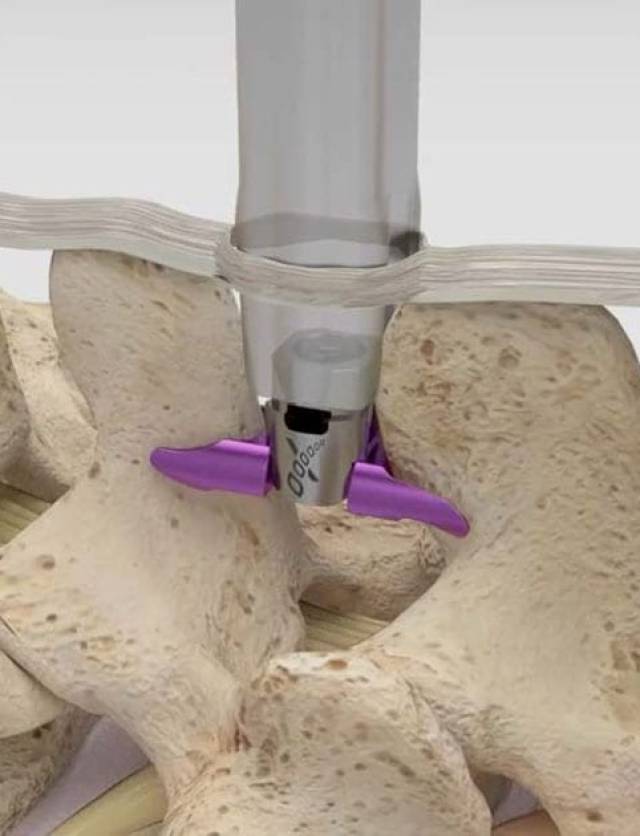Superion Interspinous Spacer (Vertiflex)
Lumbar Spinal Stenosis is a condition where the spinal canal narrows, causing pressure on the spinal cord and nerves. This pressure can lead to symptoms such as pain, tingling, numbness, and weakness in the lower back and legs. When conservative treatments like nerve blocks or epidural steroid injections are ineffective, two advanced minimally invasive options, the Mild Procedure and Vertiflex, may be recommended for treating Lumbar Spinal Stenosis. If you experience any of these symptoms, it’s crucial to consult with a doctor promptly to determine the most appropriate treatment for your condition.

Who is at risk for lumbar spinal stenosis?
Lumbar Spinal Stenosis (LSS) is a painful condition that affects the spine, often occurring in individuals over the age of 50. However, younger people may also be at increased risk if they have underlying spinal conditions, such as idiopathic scoliosis. This condition can cause discomfort due to the narrowing of the spinal canal, which puts pressure on the nerves and spinal cord.
Causes of Lumbar Spinal Stenosis
The narrowing of the spinal canal can put pressure on the spinal cord and nerves, leading to symptoms such as tingling, numbness, and weakness. The following are some of the causes of this compression:
Bone Spurs: Deterioration from arthritis can lead to the overproduction of bone in the spine, which may compress the spinal canal.
Herniated Discs: Discs act as cushions between spinal bones, and if the soft inner material of a disc leaks out, it can press on the spinal cord or nerves.
Thick Ligaments: The ligaments that help hold your spine together may become stiff and wide over time, eventually pushing into the spinal canal.
Tumors: Though less common, tumors can form inside the spinal canal and put pressure on the spinal cord or nerves.
Spinal Trauma: Injuries, such as car accidents, can cause spinal bones to break or shift, while swelling in nearby tissues post-surgery can also exert pressure on the spinal cord or nerves.
How Can I treat Lumbar Spinal Stenosis?
You can treat Lumbar Spinal Stenosis (LSS) with a combination of conservative treatments and modern alternatives. At Cellara Pain Institute, we offer the following treatments for this condition:
Epidural Steroid Injections
Nerve Blocks
Mild Procedure (Vertos Medical)
Superion Interspinous Spacer (Vertiflex)
Vertiflex Procedure
The Vertiflex procedure is a minimally invasive treatment for lumbar decompression that reduces the risks associated with traditional surgery. During this procedure, a small incision is made, and a dilator is used to gently move the tissues aside to access the spine. An implant, called Superion™, is then placed between the spinous processes of the vertebrae. This titanium alloy implant helps to reduce pressure on the nerves and spinal cord while preserving spinal motion. In some cases, more than one implant may be necessary to achieve optimal results. The procedure typically takes 20-30 minutes.
Benefits of the Vertiflex Procedure:
No need for stitches
Can be performed under local anesthesia
Outpatient procedure
Fast, safe, and effective
Minimal scarring, leading to quick healing of the treatment area
What Can I Expect During a Superion Interspinous Spacer Treatment?
The Superion Interspinous Spacer treatment, part of the Vertiflex procedure, is a minimally invasive approach to lumbar decompression. Here’s what you can expect:
Preparation: A small incision is made at the treatment site, and a tiny tube (called a dilator) is used to move tissues aside and reach the spine.
Implantation: Once the area is properly accessed, a Superion™ implant, made of titanium alloy, is inserted between the spinous processes of the vertebrae. This implant helps reduce pressure on the spinal nerves and cord while allowing spinal motion to be maintained.
Duration: The procedure is quick, typically taking 20-30 minutes to complete.
Possible Need for Multiple Implants: In some cases, more than one Superion™ implant may be required to achieve the desired results, depending on your condition.
This treatment offers significant relief with minimal downtime and quick recovery.
What Are The Benefits of Vertiflex?
The Vertiflex procedure offers numerous advantages, making it a highly effective alternative to traditional surgery for lumbar decompression:
No stitches required
Local anesthesia can be used, avoiding the need for general anesthesia
Outpatient procedure, allowing you to return home the same day
Fast, safe, and effective treatment with quick results
Minimal scarring for a faster recovery and aesthetic benefits
Reduced risk of infection compared to traditional surgery
Minimal blood loss during the procedure
Spinal motion preserved, maintaining your flexibility
Minor side effects, typically manageable and temporary
High success rate, offering a reliable solution for many patients
These benefits make Vertiflex a preferred choice for individuals seeking relief from lumbar spinal stenosis without the risks and recovery time associated with open surgery.
Can I Benefit from Vertiflex?
The Vertiflex procedure is an ideal treatment for cases of spinal stenosis caused by disc herniation or bony overgrowths of the facet joints. If you’re experiencing any of the following symptoms, you might be a good candidate for Vertiflex or other LSS treatments:
Pain in the lower back and legs
Tingling, numbness, or weakness in the lower back and legs
Difficulty walking or standing for extended periods
Loss of bladder or bowel control
If you’re experiencing any of these symptoms, call 973-377-6700 to request an appointment. For patients in New Jersey, Cellara Pain Institute offers services in Madison, as well as in nearby areas. We’re here to guide you through the process and help you find fast, safe, and effective relief.
